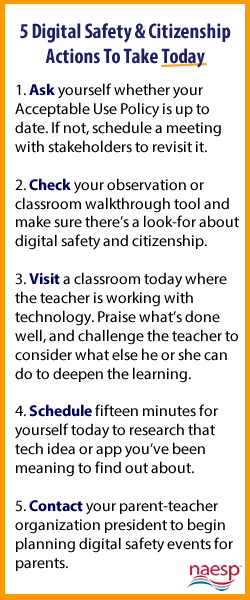Digital Safety Strategies for Principals
Communicator February 2014, Volume 37, Issue 6 Digital Learning Day, a national salute to technology innovation in schools, took place February 5. Thousands of educators celebrated in the Library of Congress, classrooms, libraries—and even on Twitter.
Communicator
February 2014, Volume 37, Issue 6
Digital Learning Day, a national salute to technology innovation in schools, took place February 5. Thousands of educators celebrated in the Library of Congress, classrooms, libraries—and even on Twitter.
NAESP celebrated by hosting a Digital Learning Day tweetchat to explore an important role that principals play in digital innovation: ensuring that students are safe online. Over 100 educators joined the #digisafety chat, moderated by Sandra Trach, principal of Estabrook Elementary School in Lexington, Massachusetts.
Trach, who wrote “Safe Digital Citizenship” for the November/December 2013 issue of Principal, led the discussion on questions from guiding parents through digital safety issues to developing Acceptable Use Policies to serving as a tech role model for students and staff.
Making sure families are on board with digital safety emerged as a major theme during the chat.
“We need to encourage basic digital literacy competencies with parents,” tweeted Trach. “Invite them to be partners.”
 Chat participants exchanged ideas on how to engage families as partners, including:
Chat participants exchanged ideas on how to engage families as partners, including:
@Sandra_Trach: We’re all models of learning, digital and otherwise. [We must] model the literacies we expect in our students.
@spaul6414: [We should] present to parents at PTO/PTA meetings about digital citizenship for parents.
@Joe_Mazza: Providing info nights & “social media tastings” for parents led by students & teachers is a great way to build capacity with families.
@Katie_M_Ritter: [I’m] holding a digital citizenship day for kids this month, with a parent session afterward!
Principals also swapped tips on crafting Acceptable Use Policies (AUPs). Trach steered educators to these guidelines from Common Sense Media on AUPs. Other AUP tips include:
@spaul6414: I have an AUP, but would prefer a “Responsible Use Agreement.” [This uses] positives rather than “don’ts.”
@Sandra_Trach: Be clear about your mission, vision, beliefs. Reflect these in your AUP. Examine and select from samples; connect your AUP to your learning goals.
@mmiller7571: Include input from multiple stakeholders.
The discussion culminated in a resounding call for principals to model the behaviors that students should exhibit. “Use [technology] often, everywhere,” tweeted Peter Carpenter (@drpcarpenter). “Get teachers and parents to ask, ‘How’d you do that?’ and show them.”
Other participants suggested that principals blog, tweet, “flip” staff meetings, use the programs Edmodo or Todaysmeet, and integrate technology into professional learning. Or, as Katie Ritter (@Katie_M_Ritter) put it, “Get connected! You can’t model #digcit if you’re not a digital citizen yourself!”
Visit NAESP’s Storify page for a full recap of the chat, as well as summaries of the discussions on firewalls/filtering and family engagement.
—
Copyright © 2014. National Association of Elementary School Principals. No part of the articles in NAESP magazines, newsletters, or website may be reproduced in any medium without the permission of the National Association of Elementary School Principals. For more information, view NAESP’s reprint policy

